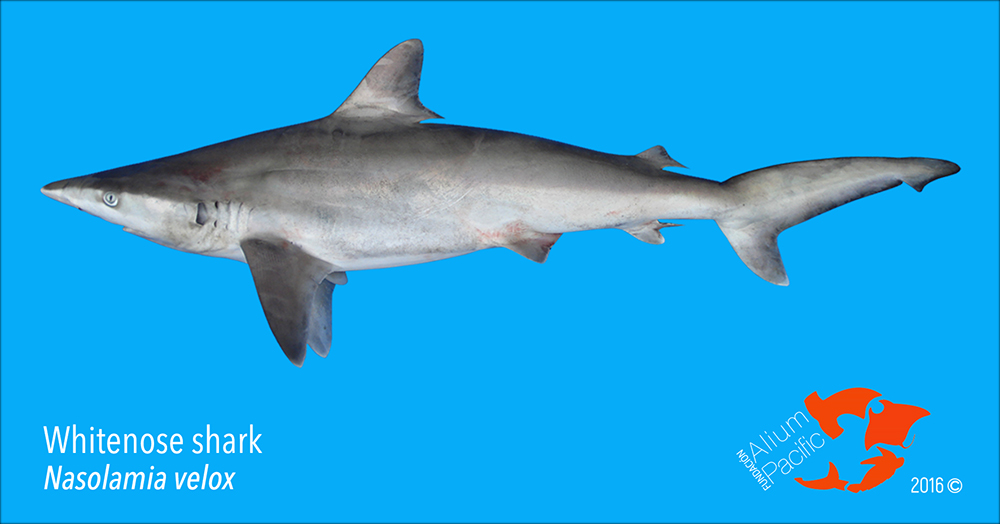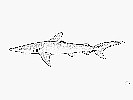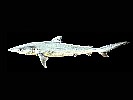Nasolamia velox
(Gilbert, 1898)
Whitenose shark
Classification: Elasmobranchii Carcharhiniformes Carcharhinidae
Reference of the original description
The fishes of North and Middle America: a descriptive catalogue of the species of fish-Iike vertebrates found in the waters of North America, north of the Isthmus of Panama. Part III. Bulletin of the United States National Museum, 47(3), 2183a–3136
The fishes of North and Middle America: a descriptive catalogue of the species of fish-Iike vertebrates found in the waters of North America, north of the Isthmus of Panama. Part III. Bulletin of the United States National Museum, 47(3), 2183a–3136
Synonyms / new combinations and misspellings
Carcharhinus velox, Carcharias velox, Carcharinus velox, Eulamia velox
Carcharhinus velox, Carcharias velox, Carcharinus velox, Eulamia velox
Description :
Citation: Nasolamia velox (Gilbert, 1898): In: Database of modern sharks, rays and chimaeras, www.shark-references.com, World Wide Web electronic publication, Version 12/2025
Please send your images of "Nasolamia velox" to info@shark-references.com

Nasolamia velox (Gilbert, 1898), 102 cm TL, female, place of catch: Puerto López, Ecuador © Colombo Estupiñán-Montaño

Nasolamia velox (Gilbert, 1898), 102 cm TL, female, place of catch: Puerto López, Ecuador © Colombo Estupiñán-Montaño
Common names
 Cazon,
Cazon,  Cazón coyotito,
Cazón coyotito,  Cazón trompa blanca,
Cazón trompa blanca,  Pico blanco,
Pico blanco,  Tiburón,
Tiburón,  Tiburón coyotito,
Tiburón coyotito,  Tollo,
Tollo,  Requin nez blanc,
Requin nez blanc,  Requiem shark,
Requiem shark,  Whitenose shark
Whitenose shark
 Cazon,
Cazon,  Cazón coyotito,
Cazón coyotito,  Cazón trompa blanca,
Cazón trompa blanca,  Pico blanco,
Pico blanco,  Tiburón,
Tiburón,  Tiburón coyotito,
Tiburón coyotito,  Tollo,
Tollo,  Requin nez blanc,
Requin nez blanc,  Requiem shark,
Requiem shark,  Whitenose shark
Whitenose shark
Short Description
Diagnose after Compagno,1984 [517]: Field Marks: A slender requiem shark, with a very long, conical snout and very large, close-set nostrils, these separated by a space only slightly greater than the nostril width, a black spot outlined with white on the dorsal snout tip; form otherwise like that of the grey sharks, Carcharhinus species (especially C. acronotus, see remarks above). Diagnostic Features : Body rather slender. Head very narrow, conical and only slightly depressed, not trowel-shaped; snout narrowly pointed in dorsoventral view, very long, with preoral length greater than internarial space and mouth width; eyes fairly large, without notches; spiracles absent; no papillose gillrakers on internal gill openings; nostrils very large, close-spaced and nearly transverse, internarial space about 1.1 to 1.3 times the nostril width; anterior nasal flaps vestigial, not tubular; labial furrows very short, uppers shorter than lowers and falling far behind eyes; teeth differentiated in upper and lower jaws; upper anteroposteriors with fairly broad semierect to oblique cusps, distal blades and serrations but no cusplets; lowers with slender, narrow, semierect cusps, blades and serrations but no cusplets; lower teeth not prominently protruding when mouth is closed; 27 to 30/24 to 28 (usually 28/25 to 27) rows of teeth. Interdorsal ridge absent; no dermal keels present on, caudal peduncle; upper precaudal pit transverse and crescentic. First dorsal origin over pectoral inner margins, its midbase somewhat closer to pectoral bases than pelvic, and its free rear tip slightly anterior to pelvic origins; second dorsal fin much smaller than first, its height less than 1/3 of first dorsal height; its origin over or slightly anterior to anal insertion; pectoral fins moderately broad and triangular, slightly falcate, pectoral length from origin to free rear tip about 3/4 of pectoral anterior margin; pectoral origins under third gill slit or interspace between third and fourth gill slits; anal slightly larger than second dorsal, with short preanal ridges and a deeply notched posterior margin. Colour light grey or brownish grey above, without a colour pattern. Moderately large sharks, adults not exceeding 1.6 m.
Diagnose after Compagno,1984 [517]: Field Marks: A slender requiem shark, with a very long, conical snout and very large, close-set nostrils, these separated by a space only slightly greater than the nostril width, a black spot outlined with white on the dorsal snout tip; form otherwise like that of the grey sharks, Carcharhinus species (especially C. acronotus, see remarks above). Diagnostic Features : Body rather slender. Head very narrow, conical and only slightly depressed, not trowel-shaped; snout narrowly pointed in dorsoventral view, very long, with preoral length greater than internarial space and mouth width; eyes fairly large, without notches; spiracles absent; no papillose gillrakers on internal gill openings; nostrils very large, close-spaced and nearly transverse, internarial space about 1.1 to 1.3 times the nostril width; anterior nasal flaps vestigial, not tubular; labial furrows very short, uppers shorter than lowers and falling far behind eyes; teeth differentiated in upper and lower jaws; upper anteroposteriors with fairly broad semierect to oblique cusps, distal blades and serrations but no cusplets; lowers with slender, narrow, semierect cusps, blades and serrations but no cusplets; lower teeth not prominently protruding when mouth is closed; 27 to 30/24 to 28 (usually 28/25 to 27) rows of teeth. Interdorsal ridge absent; no dermal keels present on, caudal peduncle; upper precaudal pit transverse and crescentic. First dorsal origin over pectoral inner margins, its midbase somewhat closer to pectoral bases than pelvic, and its free rear tip slightly anterior to pelvic origins; second dorsal fin much smaller than first, its height less than 1/3 of first dorsal height; its origin over or slightly anterior to anal insertion; pectoral fins moderately broad and triangular, slightly falcate, pectoral length from origin to free rear tip about 3/4 of pectoral anterior margin; pectoral origins under third gill slit or interspace between third and fourth gill slits; anal slightly larger than second dorsal, with short preanal ridges and a deeply notched posterior margin. Colour light grey or brownish grey above, without a colour pattern. Moderately large sharks, adults not exceeding 1.6 m.
Distribution
Eastern Pacific: Baja California, Mexico and the Gulf of California to Peru. Source: www.gbif.org
Eastern Pacific: Baja California, Mexico and the Gulf of California to Peru. Source: www.gbif.org
Human uses
fisheries: minor commercial; price category: medium; price reliability: very questionable: based on ex-vessel price for species in this family
fisheries: minor commercial; price category: medium; price reliability: very questionable: based on ex-vessel price for species in this family
Biology
Viviparous, placental [733]. Five pups of about 53 cm TL in each litter [16090]. Distinct pairing with embrace [17086]. Found inshore and offshore on the continental shelves. Feeds on small bony fish, including anchovies, and crabs.
Diet: Ecuadorian Pacific [25131]: (data basis: 24 (17 females, 7 males TL: 67 cm - 192 cm TL, 12 specimen with emty stomach): The authors identified 17 dietary components as well as the remains of unidentified organisms. Based on the %IRI, the N. velox diet was composed of teleosts, cephalopods and crustaceans; the most important prey were the cephalopod Dosidicus gigas (22.46%), L. argenteus (7.22%), Cynoscion sp. (5.77%) and Lophiodes spilurus (4.4%). The male diet was dominated by teleosts and cephalopods, with the most important prey being the fishes L. spilurus (27.18%), Polydactylus opercularis (21.13%) and L. argenteus (13.29%). In contrast, the female diet also included crustaceans, of which D. gigas (%IRI ¼ 26.87%), members of the Ophidiidae family (2.7%) and Oxyporhamphus micropterus (2.67%) were the most important.
Viviparous, placental [733]. Five pups of about 53 cm TL in each litter [16090]. Distinct pairing with embrace [17086]. Found inshore and offshore on the continental shelves. Feeds on small bony fish, including anchovies, and crabs.
Diet: Ecuadorian Pacific [25131]: (data basis: 24 (17 females, 7 males TL: 67 cm - 192 cm TL, 12 specimen with emty stomach): The authors identified 17 dietary components as well as the remains of unidentified organisms. Based on the %IRI, the N. velox diet was composed of teleosts, cephalopods and crustaceans; the most important prey were the cephalopod Dosidicus gigas (22.46%), L. argenteus (7.22%), Cynoscion sp. (5.77%) and Lophiodes spilurus (4.4%). The male diet was dominated by teleosts and cephalopods, with the most important prey being the fishes L. spilurus (27.18%), Polydactylus opercularis (21.13%) and L. argenteus (13.29%). In contrast, the female diet also included crustaceans, of which D. gigas (%IRI ¼ 26.87%), members of the Ophidiidae family (2.7%) and Oxyporhamphus micropterus (2.67%) were the most important.
Remarks
shark-references Species-ID=4066;
shark-references Species-ID=4066;


















